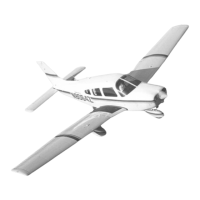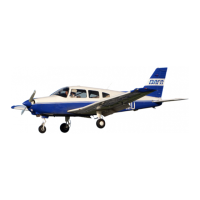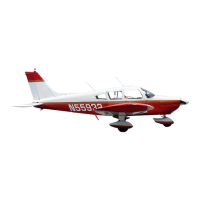PIPER AIRCRAFT, INC.
PA-28-161, WARRIOR III
MAINTENANCE MANUAL
PAGE 13
Nov 30/06
3E23
32-40-00
(d) Close the open bleeder fitting to which the pressure hose is attached. Do not remove the
tube from the fluid reservoir until both brakes have been bled. Check the brakes on the
side being bled for proper pedal pressure. Replace cap on bleeder fitting.
NO
TE: It may be necessary to remove any trapped air in the top of the wheel brake unit
by applying pressure to the system with the brake hand lever and slowly opening
the bleeder and release the hand lever.
(e) Repeat steps b through d to the left main landing gear.
(f) Drain excess fluid from the reservoir to fluid level with a syringe.
(3) Bleeding Brakes After A Component Has Been Changed
CA
UTION: DO NOT ALLOW PRESSURE TO BLEED OFF BEFORE CLOSING BLEEDERS
FOR THIS WILL ALLOW AIR TO ENTER THE SYSTEM. REPEAT THE
PUMPING AND BLEEDING APPROXIMATELY 10 OR MORE TIMES OR UNTIL
ALL THE AIR IS RELEASED FROM THE SYSTEM. DURING ALL BLEEDING,
FLUID LEVEL OF THE RESERVOIR MUST BE MAINTAINED.
(a) Actuate the hand brake handle until some pressure builds up in the system. At this time,
crack the attaching B nuts at any of the hose connections of the replaced unit. Most of the
handle sponge feeling should be displaced by this action.
(b) Actuate the master cylinder and the toe brake cylinder on the side where the component
was changed and bleed fluid through the brake assembly on the wheel by pumping
pressure and cracking bleeder until pressure drops.
F. Brake System Leak Check
Pull for a good, firm hand brake and lock parking brake mechanism. Allow system to stand for
approximately 10 minutes, then by gripping the park brake handle it should not be able to be pulled
aft further than the original set. Should the handle be able to be pulled towards the panel and feel
spongy, a leak is present at some point in the system. This leak may appear at any one of the
connections throughout the system or internally in the master brake cylinder or wheel brake
assemblies.

